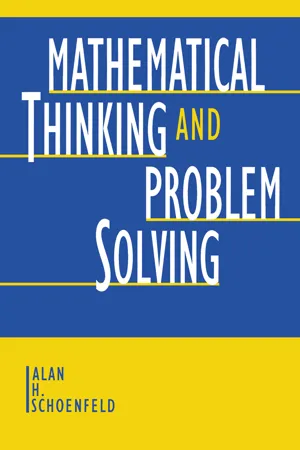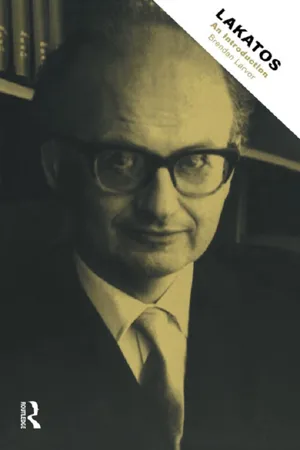Disproof by Counterexample
Disproof by counterexample is a method used to refute a mathematical statement by providing a specific example that contradicts it. In this approach, a single instance is sufficient to disprove a general claim. By demonstrating that the statement does not hold true for a particular case, the validity of the overall assertion is undermined.
3 Key excerpts on "Disproof by Counterexample"
- eBook - ePub
- Alan H. Schoenfeld, Alan H. Sloane, Alan H. Schoenfeld, Alan H. Sloane(Authors)
- 2016(Publication Date)
- Routledge(Publisher)
...Must it also satisfy the conclusion? If the answer in all cases is yes, then the statement is true. If, on the other hand, there are some elements in the domain that satisfy the hypothesis and not the conclusion, then the statement is false. Yet, again, if there are no elements in the domain that satisfy the hypothesis and not the conclusion, then the statement is true. And that is it. Direct proof, Disproof by Counterexample, and proof by contradiction are three aspects of the same whole. One arrives at one or the other by a thoughtful examination of the given statement, knowing what it means for a statement of that form to be true or false. Proof and disproof are, therefore, indispensible tools, not just to check after the fact that one’s illogical (or, better, alogical) intuitions have brought one to the correct answer to a mathematical question, but to be used side by side with intuition throughout the problem-solving process. Deductive logic is in every nook and cranny of this process. In just the three examples discussed, I needed to use the facts that the negation of a universal statement is existential, that the negation of an existential statement is universal, and that if a property is true for all elements of a set, then it is true for each individual element of the set (universal instantiation)...
...The counterexample is the antithesis. The synthesis is the improved theorem and proof complex which is arrived at by proof-analysis and lemma-incorporation. An important feature of this pattern is that the process of proof and criticism is creative (pace Popper), giving rise to new conjectures and new proof-generated concepts. This is possible because the counterexample does not only show that the naive conjecture is false: it points to a specific problem, the solution of which leads to a new conjecture. In Hegelian jargon, the counterexample does not stand in ‘bare opposition’ to the original conjecture and proof complex but rather offers a ‘determinate (i.e. specific) negation’ of it. The synthesis in this dialectical three-step does not unite the best of the thesis and the antithesis. Rather, the synthesis solves the problem posed by the antithesis for the thesis. This Hegelian gloss on the method of proofs and refutations occurs in Lakatos’ discussion of Seidel’s discovery of uniform convergence. He claims that ‘The Hegelian language, which I use here, would, I think, generally be capable of describing the various developments in mathematics. (It has, however, its dangers as well as its attractions.)’ (P&R, p. 145). The particular danger that Lakatos seems to have had in mind originates in the fact that reason in general, and mathematical dialectic in particular, must be realised in human beings, human institutions and (nowadays) human-built machines. Mathematicians and mathematical institutions are vulnerable to all the ills that flesh is heir to, and consequently there is no guarantee that mathematics will always develop rationally, or indeed at all. The austerity of Hegel’s dialectical writing obscures this fact, leaving the impression that logical necessity alone is sufficient to ensure the progress of whatever body of thought is in question...
- eBook - ePub
- Valsa Koshy, Ron Casey, Paul Ernest, Valsa Koshy, Ron Casey, Paul Ernest(Authors)
- 2014(Publication Date)
- Routledge(Publisher)
...Chapter 8 Mathematical proof DOI: 10.4324/9780203984062-10 In the previous chapter the distinction was made between a sample and a population. A central problem for statisticians is that of devising ways of thinking which guard against ‘jumping to conclusions’ and attributing to a whole population what has been found out about a sample, without a scientific word of caution about the confidence you can legitimately have in such conclusions. In many respects, this is also a central, and much neglected, concern within mathematics. Remember the definitions of the universal and existential quantifiers in Chapter 4, Section 5. Their use is in emphasising the difference between cases of something being true for all possibilities and something being true for just some possibilities. In this chapter the notion and strategies of proof will be explored. The appreciation of what is involved in designing your own proofs and following the proofs of others will, it is hoped, be enhanced by contrasting proof with strategies of provision of partial evidence for generalisations. The citing of particular examples, the use of diagrams to support general arguments, the contrast between deduction and induction and the process of searching for exceptions to either disprove a generalisation or impose a limitation on it will provide the backdrop to the presentation of mathematical proof. 8.1 The role of induction The phrase ‘jumping to conclusions’ suggests the procedure of concluding that something is true of a large group of things on the basis of believing it is true of a smaller group of things and that such a procedure is flawed or unjustified. Before considering mathematical examples, let us reflect on what is involved in a few non-mathematical cases of our beliefs. ‘Night follows day’ is something we believe because of our past experience of days of living. The fact that we have not experienced future days to confirm that day will be followed by night does not undermine our belief...


